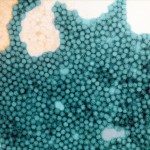Lien vers Pubmed [PMID] – 27958320
Sci. Rep. 6, 38831
The attenuated Sabin strains contained in the oral poliomyelitis vaccine are genetically unstable, and their circulation in poorly immunized populations can lead to the emergence of pathogenic circulating vaccine-derived polioviruses (cVDPVs). The recombinant nature of most cVDPV genomes and the preferential presence of genomic sequences from certain cocirculating non-polio enteroviruses of species C (EV-Cs) raise questions about the permissiveness of genetic exchanges between EV-Cs and the phenotypic impact of such exchanges.
We investigated whether functional constraints limited genetic exchanges between Sabin strains and other EV-Cs. We bypassed the natural recombination events by constructing 29 genomes containing a Sabin 2 capsid-encoding sequence and other sequences from Sabin 2 or from non-polio EV-Cs.
Most genomes were functional. All recombinant viruses replicated similarly in vitro, but recombination modulated plaque size and temperature sensitivity. All viruses with a 5′UTR from Sabin 2 were attenuated in mice, whereas almost all viruses with a non-polio 5′UTR caused disease. These data highlight the striking conservation of functional compatibility between different genetic domains of cocirculating EV-Cs. This aspect is only one of the requirements for the generation of recombinant cVDPVs in natural conditions, but it may facilitate the generation of viable intertypic recombinants with diverse phenotypic features, including pathogenicity




